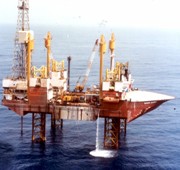 State-owned Oil and Natural Gas Corp has over 1.7 billion tonnes of oil reserves in its domestic and foreign fields, according to independent audits.
State-owned Oil and Natural Gas Corp has over 1.7 billion tonnes of oil reserves in its domestic and foreign fields, according to independent audits.ONGC's 64 domestic fields have a total reserve of 1.06 billion tonnes of oil and oil equivalent natural gas, while its 12 properties in countries like Russia and Sudan hold almost 640 million tonnes of reserves.
The company, in preparation for its share sale next month, had engaged Gaffney Cline and Associates and DeGolyer and MacNaughton to audit its 64 domestic fields and assets in Russia, Sudan, Syria, Brazil, Colombia, Venezuela, Vietnam, Myanmar and Egypt, said official sources.
While GCA prepared audited estimates for ONGC's giant Mumbai High field, D&M carried audit of 63 other domestic fields and the overseas assets.
The government plans to sell 5 per cent of its shareholding in ONGC in the follow-on public offer next month to raise Rs. 12,000-13,000 crore (Rs. 120-130 billion).
According to the audit estimates, the 64 fields have proved or 1P reserves of 612.55 billion tonnes of oil and oil-equivalent gas.
Furthermore, 888.04 million tonnes were estimated as probable or 2P reserves which have at least 50 per cent chance of being produced.
Another 1.06 billion tonnes of reserves were classified as possible or 3P which have a 10 per cent chance of being recovered.
D&M estimated that the firm's overseas assets hold 1P reserve of 119.977 million tonnes, 2P reserve of 288.299 million tonnes and 3P reserve of 639.706 million tonnes of oil and oil equivalent gas.
The audited estimates are higher than ONGC's self assessment that put domestic and overseas reserves at 1.655 billion tonnes (3P reserves).
1P reserves were estimated at 951.77 milion tonnes and 2P reserves were put at 1.4 billion.
Sources said ONGC's self-assessment put 1P, 2P and 3P reserves in domestic fields at 770.86 million tonnes, 1 billion tonnes and 1.21 billion tonnes respectively.
For overseas assets, the figures were 180.91 million tonnes, 404.16 million tonnes and 445.61 million tonnes oil and oil equivalent gas.
Sources said oil reserves were primarily a measure of geological risk - of the probability of oil existing and being producible under current economic conditions using current technology.
The three categories of reserves generally used are proven (reasonably certain to be producible), probable (50 per cent chance of these being produced) and possible reserves (having 10 per cent certainty of being produced).
The reserve audit will help ONGC get a good response to the planned share sale likely to open on March 15.
GCA estimated 1P, 2P and 3P oil reserves at Mumbai High fields off the west coast at 134.20 million tonnes, 239.70 million tonnes and 269.50 million tonnes of oil respectively.
These were higher than ONGC's estimate of 125.09 million tonnes of 1P and 190.07 million tonnes of 3P reserves, the report said.
For natural gas, GCA estimated 1P reserves of 42.54 million tonnes oil equivalent and 3P reserves of 80.40 million tonnes at Mumbai High.
These are compared to the ONGC's estimate of 48.68 million tonnes of 1P and 73.97 million tonnes of oil equivalent 3P reserves.
D&M for the 63 fields estimated 1P reserve of 194.64 million tonnes of oil and 241.17 million tonnes of oil equivalent gas.
It put 2P and 3P reserves at 232.78 million and 288.90 million tonnes of oil respectively. Gas equivalent reserves were put at 241.17, 347.32 and 422.71 million tonnes.
"The principal difference between the ONGC's estimates and the GCA's estimates are that GCA has considerable aggressive water injection in the field, which would enhance life of the field and higher ultimate recovery," said the reserve report.








